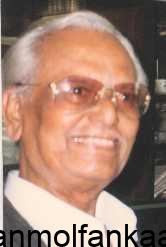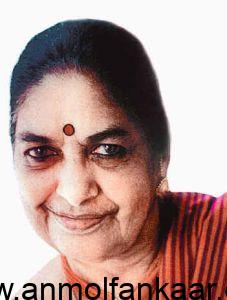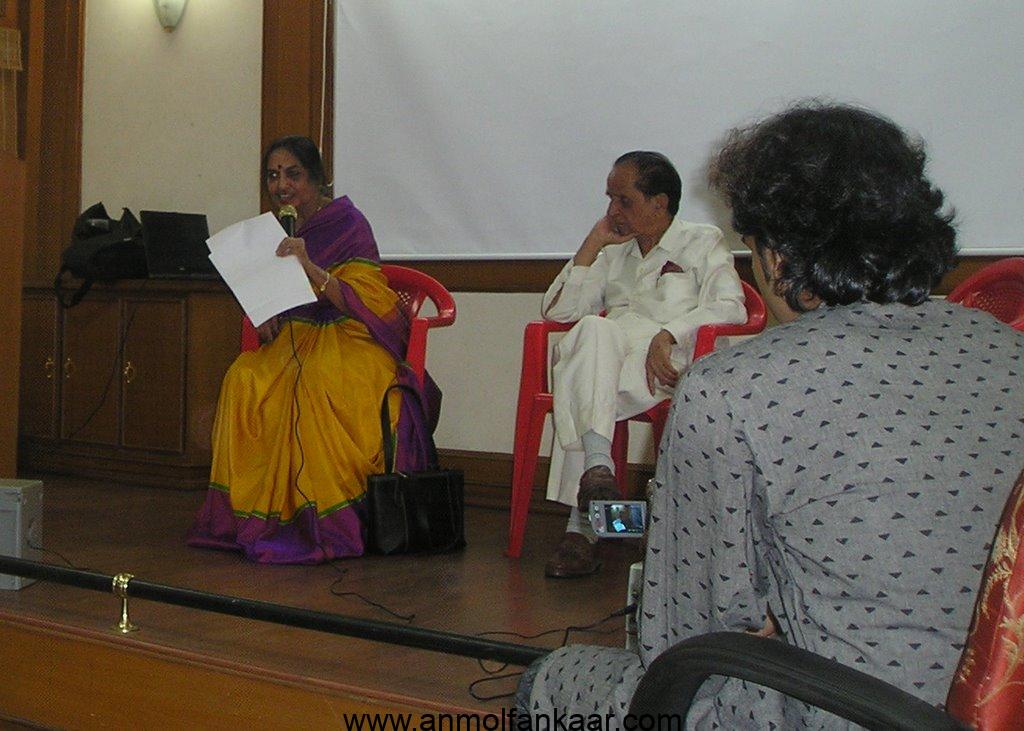Written by Chiranjiv Singh ji, Former Indian Ambassador to UNESCO

Anil Biswas was doing the final rehearsal for a song for Aarzoo with Lata Mangeshkar when he heard someone sobbing behind him. He gave a swipe backwards and the backhand hit the sobbing person. Anil Da looked back and saw it was Roshan. “Arre tu kyon ro raha hai?”, he asked, and Roshan, still sobbing replied, “Mujhse aisa gaana kabhi nahi ban sakega”. “Tu ro mat. Main tujhe ashirwad deta hoon; tu mujhse bhi accha gana banayega”. The song was “Kahan tak hum uthayen Gham”. Roshan acknowledged the blessing by using the tune as band music for a Baraat scene in Bawre Nain, (which was Roshan’s first major hit).
Anil Biswas was truly a composers’ composer. C. Ramachandra, Roshan, Madan Mohan were his disciples, (C. Ramachandra even worked as his assistant for a while). Naushad and O.P. Nayyar admitted that they grew up admiring Anil Da’s tunes. Anil Biswas’s film career sums up the history of film music of the golden era. His film career started in 1934 when he came to Bombay from Calcutta and ended in 1964 when his last film Chhoti Chhoti Batein, produced by his old friend, Moti Lal,was released. (After that he gave music for some documentaries and Doordarshan serials,and worked for All India Radio). Anil Biswas was in the process of moving to Delhi when Moti Lal insisted, ” Anil iska music tum hi karoge”. And Anil Biswas gave a memorable score for the film — a fitting finale.

Anil Biswas despaired of making a singer out of Moti Lal. But he managed it. He used to narrate hilarious incidents about making singers out of actors like Moti Lal and actors out of singers like Akhtari Bai. It was this that led him to introduce playback singrng. It was a coincidence that Pankaj Mullick in Calcutta and Saraswati Devi and Anil Biswas in Bombay hit upon the idea of playback singing in the same year unknown to each other, he told me. The rest is musical history. He was the first to use a modern orchestra in Hindi film music, first to use fusion music, first to use counter melody, and operatic structure for a film score (Mehboob’s Roti 1942, for which the initial story idea was given by Anil Da). In those pioneering days for every problem solutions had to be found as they went along: “Hum ko jab pyas lagi to khud hi kuan khoda aur khud hi pani piya”, he used to say about his experiments and innovations. A chronological selection of his songs would be an accurate record of the development of Hindi film music. AniI Da said to me once, “Dekho, R.C. Boral film music ke Baap hain aur main Chacha”. He called R.C. Boral father of film music because he perfected the format of film songs with prelude, Sthayee, interlude, and Antara. This format remains unchanged.
It was to this Chacha that Moti Lal one day brought a young man and introduced him, saying, “This young man is my relative. He is fond of singing. See if you can make something out of him.” Out of regard for Moti Lal, Anil Biswas agreed to give the young man a chance in Pehli Nazar (1945). After a few rehearsals the song was ready for recording; the studio was booked; the orchestra was waiting; but the young singer was missing. Anil Biswas was furious. He called Moti Lal, who did not know where the young man was. After a few calls he was traced at a place where he was playing cards with some friends and drinking. The prospect of recording with Anil Biswas had made the young singer nervous and to steady himself he had been drinking and lost track of time while playing cards. Anil Biswas took a car, reached the place where the card game was on, slapped the young man, dragged him to the car, took him to the studio, dunked his head in a basin of water, which sobered him and recorded the song “Dil jalta hai to jalne de,” in a single take. This is how Mukesh’s career took off. Anil Da used to say jokingly that perhaps his slap had given that extra touch of pathos to Mukesh’s voice in ‘Dil jalta hai to jalne de’ , which is one of Mukesh’s all time great songs, and the first fllm song, according to Anil Da, based on Mishra Darbari. AniI Da had great affection for Mukesh. He groomed Mukesh and helped him come out Sehgal’s shadow.

Another gift of Anil Biswas to the Hindi film music was Talat Mahmood, who remained his favourite till the end, along with Mukesh and Manna Dey. Anil Da always spoke of Talat Mahmood with deep affection. Talat also said in an interview which was telecast a few years back, “Mere to bas le de ke ek Anil Da hi hain”. Talat’s first song for Anil Da is also a classic: “Ai dil mujhe aisi jagah le chal jahan koi na ho” (Aarzoo 1950). Anil Biswas mentored and guided Talat Mahmood in the formative stage of his career. When other composers told Talat that his voice was shaky, it was Anil Biswas who told him that the vibrato in his voice was his uniqueness and strength and restored his confidence. Thanks to Anil Bisawas’s guidance Talat Mahmood reached great heights as a singer and exponent of ghazal. Manna Dey, has said that the finest classical Hindi filrn song of all time is Anil Da’s ‘Ritu aaye ritu jaaye’, sung by Manna Dey and Lata Mangeshkar for Hamdard 1953 (which was Biswases’ home production). Hamdard was an ordinary film with extraordinary music. About its music Dada said, “I wanted to show in one film all the major types of our music: khayal, thumri, ghazal, Rabindra Sangeet, film song, qawwali, cabaret style song, etc”. ‘Ritu Aaye Ritu Jaaye’ is appropriately the title of Dada’s biography written by Sharad Dutt.
In his 89 years Anil Da had seen it all. Starting as a young revolutionary and being jailed, struggling in Calcutta, coming into contact with Kazi Nazrul Islam, working for theatre, coming to Bombay, teaming up with Mehboob, reaching the top with films like Ali Baba, Aurat, Roti, Bahen, Kismat, experiencing triumphs and tragedies, finding the love of his life in Meena Kapoor and marrying her, leaving Bombay after personal tragedies (especially the death of his son in an air crash, who was an air force officer), joining the All India Radio (Vividh Bharati was inaugurated with his song, ‘Naach re mayura’, sung by Manna Dey, which Dada composed specially for the occasion), working on the orchestration of Indian music, joining the faculty of music of Jawaharlal Nehru University, composing for television (Hamlog), ballets (Krishna Leela, Hoysala Vaibhava, Amir Khusro etc.) having mehfils at home with friends like Faiz Ahmed Faiz dropping in, and finally a quiet contemplative life devoted to Shirdi Sai Baba. His only worldly tie, he said, was Meena ji. Her well-being after him was his main concern.
Anil Biswas was one of our most intellectual composers; he was a formidable scholar and musicologist. He used to sparkle in the company of friends, enlivening the gathering with his wit, humour, sharp repartee and original insights. A robust singer himself, he would illustrate his point by singing. Talking of folk music, once he said to me, “See, each region’s folk music has one or two presiding ragas; lt is Desh and Bilawal for Bengal, Bhairavi and Pahadi for Punjab, Maand for Rajasthan…”, and he mentioned all the regions and their ragas. He illustrated his thesis by singing. I wished I had a tape recorder with me; this treatise on folk music and classical music and how they borrowed from and enriched each other was a memorable exposition of the subject.
Anil Biswas had undertaken a tour along with his friend Ghulam Haider, another great composer, who revolutionized film music, collecting folk tunes and discovering singers. Many of the folk tunes found their way into the compositions of these great composers. Some were given to other composer friends also. “Dheere se aaja ree akhiyan mein”, for example, has its genesis in a tune which Anil Biswas had collected in Rajasthan during that tour and later passed onto his friend C. Ramchandra. “Lo, yeh tere kaam aayegi”, he said to C. Ramachndra while giving him the tune, Anil Da told me. And what a song C. Ramchandra made out of that!
It was this tour in the company of Ghulam Haider which made Anil Biswas realise the richness of Indian folk music. This richness he introduced into film music at a time when composers in Bombay were content to emulate Natya Sangeet and those in Calcutta Rabindra Sangeet, and that is his great contribution to the development of Hindi film music . He made the horizons of film music limitless.
I once remarked about the variations in the Antaras of his songs. He said, “Yes; I thought in our tradition we have in a composition Antara, Sthayee, Abhogi and Sanchari, so let me also have them”. With all that, his tunes were not laboured. He was sensitive to the nuances of language, the strength and limitation of a singer’s voice, the situation in the film, and the mood of the song. In Meena Kapoor’s famous song, “Rasiya re man basiya re” (Pardesi 1957), Dada pointed out that the Mandrabahar interlude represented the lover going away on his horse and the flute represented the anguished cry of the beloved’s heart. Listen to the song in this light and see how beautifully crafted the song is. In this song Meena Kapoor is accompanied by Mohammad Shafi on Sitar, Bala Bhau on Mandrabahar, Ritu Majumdar on Bansuri, and Chandrakant on table (incidentally, Chandrakant was called Dada’s Hanuman). You don’t need a sixty piece orchestra to create memorable melody.
Anil Da used to say about too much labouring on the tune, “If you squeeze the lemon just right you get the desired flavour; squeeze it too much and you get bitterness”. He always got the lyrics first and then set them to music. Words seem to be chiselled in his compositions. His mastery of Urdu and Hindi enabled him to bring out the subtlety of words. For example in the song ‘Mast pavan hai chanchal dhara man ki naiya dol na jaye’ every time the word ‘dol’ occurs it is given a different glide, signifying the lurching of boat. Listen to ‘O saajana’ (Heer 1956) and you marvel at his mingling of Punjabi and Bengali music, in the voices of Geeta Dutt and Hemant Kumar respectively, bridged by interludes of Punjabi folk music. How effortlessly he composed is shown by the famous ‘Seene mein sulagte hain armaan’ (Taraana 1951), one of the most beautiful duets ever composed, and one of Anil Da’s personal favourites among his compositions.
Anil Biswas and Prem Dhawan were going in a car and Prem Dhawan said “Dada, how do you like this Mukhda?” And he recited “Seene mein sulagte hain armaan…” Dada liked it. By then they were near the famous singer, Surinder Kaur’s house and Prem Dhawan wanted to see her. Dada said, “You go, I shall stay here”, arrd sat on a parapet facing the sea. A little later when Prem Dhawan returned, Dada said, “Here, I have set the tune for your Mukhda’, and he sang it. Prem Dhawan was very happy with the tune and completed the song.
One day Roshan came to Dada and sang a Punjabi folk song and asked him, “How do you like it? “Very nice”, said Dada, and started turning it around. It emerged as Meena Kapoor’s famous song ‘Kachchi hai umariya’ in Chaar Dil Chaar Rahen. When next Roshan carne excited about using that Punjabi folk tune, Dada snapped his fingers and said, “Tum baithe raho; hamne usko istemal kar liya hal’ . And Dada played the song. The Punjabi Mukhda of the song gives way to Bengali Keertan, and then an instrumental interlude based on Tamil snake charmers’ tune and finally it ends with a touch of Bihari folk songs — an all India musical journey in a span of three minutes twenty seconds.
I asked him about the rich sound of his orchestra. He gave credit for that to his assistant, Ram Singh. Anil Da told me that Ram Singh landed at his place one day from Karachi and said that he would work with him and him alone, and if that was not possible, then he would go back to Lahore. Anil Biswas agreed and it was a remarkable partnership. Ram Singh’s contribution to his music was always acknowledged with respect by Anil Biswas. The credit titles of Taraana say, “Music by Anil Biswas and Ram Singh”. He told me that he seldom used more than ten to twelve instruments. Voices and instruments were perfectly balanced in his compositions. The use of Komal Dhaivat was a characteristic feature of Anil Biswas’s compositions. “I have used Komal Dhaivat even where the raga on which the tune was based prohibited Komal Dhaivat”, Dada said. His compositions were his creations and not just renditions of Ragas.
Once Anil Da and I were discussing Urdu poetry. We agreed that Ghalib was great but Nazeer Akbarabadi was the greatest. I said, “Dada, I wish somebody would record Nazeer’s Banjara Nama”, .Dada said he would love to set it to music. He started humming and then and there composed a tune. It was a magical moment: Nazeer Akbarabadi’s Banjara Nama being set to tune and sung by Anil Biswas. I had imagined Banjara Nama being sung in the style of Bundelkhaldi balladeers. But Dada composed it as Punjabi Kaafi, which brought out the metaphysical element of the poem, like Bulleh Shah’s Kaafis.
Dada’s essay on ghazal is a masterpiece. It was written as introduction to his translation of ghazals from Urdu into Bengali, a difficult task which Dada did successfully. The collection was published as ‘Ghazaler Rang’, with binding designed by M.F. Hussain His few poems in Bengali show that if he had not become a composer, he would have become a poet. One of his poems had earned praise from Tagore also.
Along with introducing singers like Mukesh, Talat Mehmood, Zohra Bai, Akhtari Bai, Sudha Malhotra, S.D. Batish and others, Anil Da introduced poets like Sahir Ludhianvi, Josh Malihabadi and others. Safdar “Ah” and Prem dhawan remained his close friends till the end. He worked closely with the poets. Often while reading if he liked a ghazal or poem which fitted the situation of the film in hand, he would ask the poet’s permission to use it. That is how songs like ‘Tera khayal dil se bhulaya nahin abhi’, ‘Tera haath haath mein aa gaya’ and ‘Mohabbat tarq kee maine’ were born. He worked closely with Pradeep on the song ” Door hato ai dunia walo, Hindustan hamaara hai” from Kismat. when the war-time British censors objected to the song, the situation was saved by telling them that ‘Door hato ai dunia walo’ referred to Germany and Japan. But the listeners knew better.
Introducing new singers and lyricists was not always easy in that era of super talents. When Kishore Kumar was taken as hero of Fareb, Anil Biswas decided to have the songs sung by him. The word went around and people said Kishore would not be able to sing Anil Da’s compositions. “Why don’t you take Manna Dey or Rafi?”, they said. But Anil Biswas persisted with Kishore. One of them even had a bet with Dada, “If you make Kishore sing your composition, then it will be my head and your shoe”. On the day of the recording there were many curious listeners waiting to hear the result. The song, a duet with Lata, ‘Aa mohabbat ki basti basaenge hum’, was sung and recorded flawlessly. The gentleman who lost the bet bowed his head before Anil Biswas. The shoe was not used. But two more songs were recorded later by Kishore for Fareb: ‘Husn bhi hai udas udas’ and. ‘Mere sukh dukh ka sansar’. These are among the finest songs Kishore Kumar ever recorded.
When Lata Mangeshkar was a new-comer Anil Biswas taught her the technique of controlled breathing. He also helped her come out of Noor Jahan’s influence. Lata Mangeshkar called him a multi faceted genius and wrote, “I have learnt many things from Anil Biswas. The singers normally pay more attention to the tune rather than to the words of a song. There was a time, when I too did the same; but then I learnt from Anil ji how important for clarity the correct pronunciation of the words is. I studied the complexity of sound too under his supervision. And I learnt another very important thing from him: how, without breaking the tala or laya, one can breathe while singing. I practiced this very thoroughly”.
In every respect Dada’s contribution to film music is unparalleled. His admirers are countless. He treasured the appreciation of his admirers. And he got it in full measure. A Pakistani prisoner condemned to death expressed his last wish that ‘Panchhi aur pardesi donon nahin kisi ke meet’ be played by the band for his funeral. His wish was fulfilled. The song was composed by Anil Biswas.